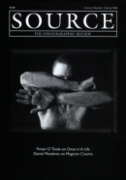Our Special Day
Our Special Day by Lawrence Cassidy was at Belfast Exposed, 1996
Review by Michael Crone
Issue 7 Spring 1996
View Contents ▸
The exhibition, entitled Our Special day, by Lawrence Cassidy showed at the Belfast Exposed gallery in Belfast. Cassidy cites the Ken Loache film Raining Stones, together with an interest in his own family history, as being the main motivational sources for originating the project. The inclusion of an extract from the play A Hero's Life by Terence Cassidy reflects this:
"I have a collection of old family photographs. Generations of aunts and uncles, nieces, nephews, brothers and sisters, of weddings and funerals and Whit Friday walks, of christening clothes and first communion dresses, mothers, fathers, sons and daughters. All no longer with us... forgotten."
When I go someone will pick up these photographs, look at them, laugh, then throw them into a dustbin. It will be as if they never existed on this earth. I can't allow that to happen, they are also heroic lives.
"I will paint these people, I will paint their portraits. Perhaps through me they might live on, only through me."
The paraphrase forms an appropriate premise to the work.
The space in which the exhibition is sited is small, lending the work intimacy. The piece comprises of a collection of black and white photographs, hung in a recurring arrangement of horizontal and vertical orientation, dependent on the nature of content. The images revolve around three themes of traditional portraiture and landscape, which merge in public events. The photographs run at a consistent height around all walls of the space. Parallel to this, a band of photocopied census documents catalogue dates, family names, addresses and place of origin.
The images present the progression of the artist's own family tree within the context of the emigration of Irish families to Manchester, during the time of, and after, the famine. History states that the Irish were brought to England as cheap labour, in this case the clay pits. Cassidy focuses on the area of Manchester known as Collymore, where many emigrants initially settled on arrival. It was hence referred to as "Irish town". The cultural and psychological effect of this transition on the people is suggested by the overall effect of the show, brought to emphasis by the documentation of the Whit Friday walks, (described by Cassidy's grandmother as 'our special day'). View of Collyhurst, 1996
View of Collyhurst, 1996
The photographs form an interrelated composition of figures, city/landscapes and events; their proximity provokes comparison and consideration, as a whole, in groups and individually. The implications of this denote relationships between individuals, social groups and place. In view of the subject, Cassidy narrates the progression of the emigrants, developing communities in densely populated areas, contrasting to the 'alien' environment. The cultural identity of the social group is concentrated and they take comfort in themselves, and their roots; this is most obvious in community events, which display not only religion and patriotism, but also a social pride. This detracts from the everyday drudgery of working class life in the industrial cities of Northern England, as inferred by the census documents, indicative of the impersonal population management policies of the time. The photographs depict a situation similar to any one of the major cities in England or America, the emigrants originating from any number of nations. Indeed an affinity is seen between the Irish and other immigrant communities, with the 'Italians marching' alongside the central subjects.
To criticise any element of the work, or to break down any one photograph would deny the accumulative effect of the whole. The evidence, or 'raw material' as Cassidy refers to the photographs, is presented as historical fact and as such the piece is documentative. The literal images suggest that academic debate or the element of 'game' is subtle, allowing access, for consideration from all perspectives. Cassidy is solid in approach to the work, providing a personal view, while the medium avoids absolutism, as do the contents. This balance avoids the insular dialect and self-obsession of the 'avant-garde', but simultaneously denies the debilitating label of 'social documentary'. Cassidy describes the work as research for a finished piece. However, as it stands the project proves to be relevant and worthwhile in development.
Other articles by Michael Crone:






